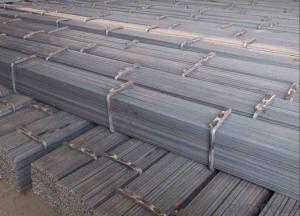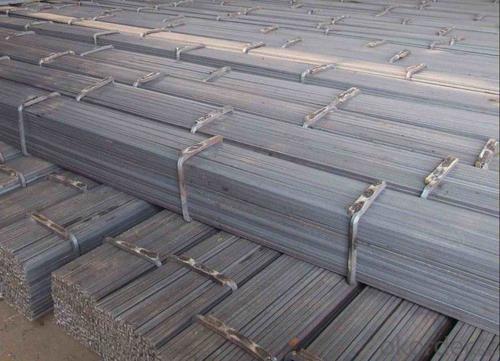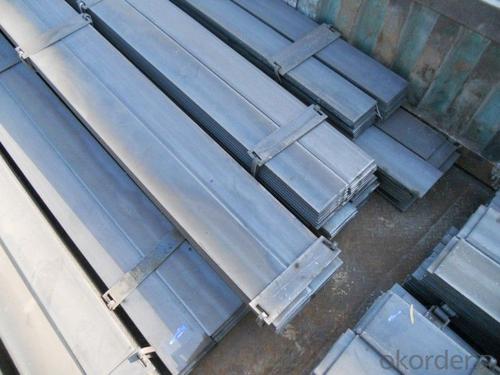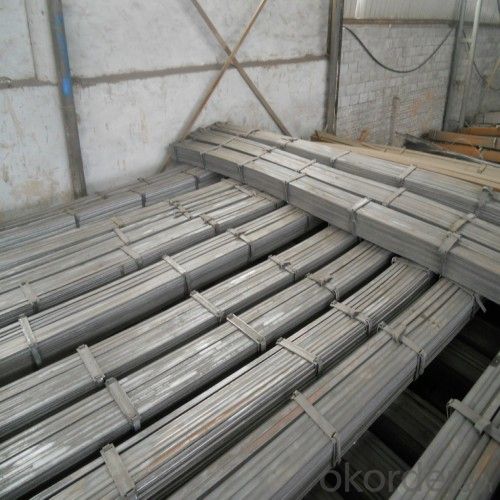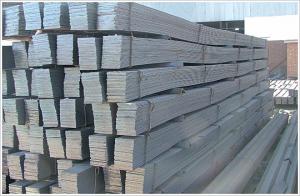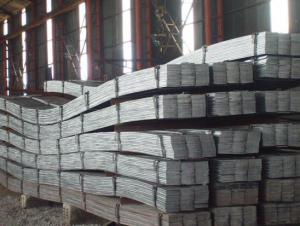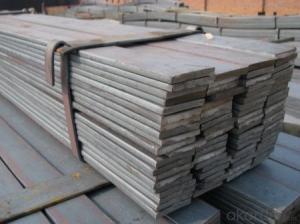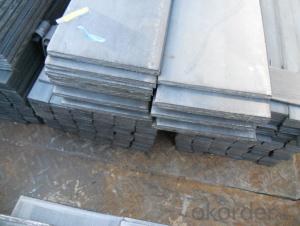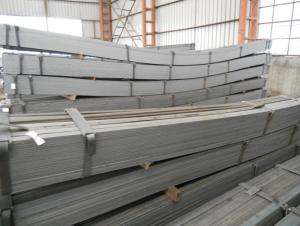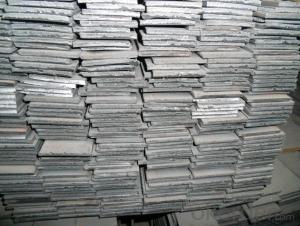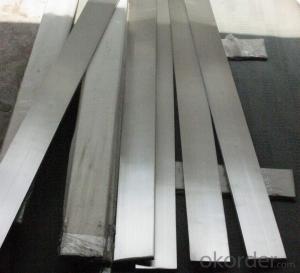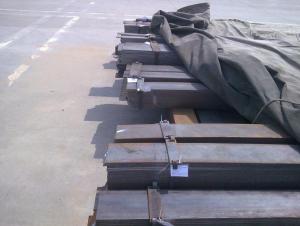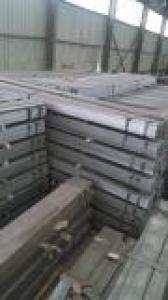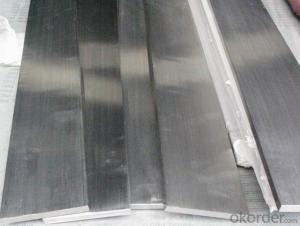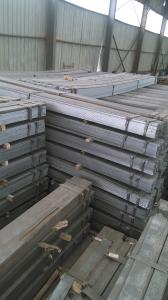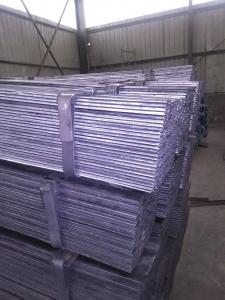Mild steel flat bars with high quality and good price
- Loading Port:
- Tianjin
- Payment Terms:
- TT OR LC
- Min Order Qty:
- 25 m.t.
- Supply Capability:
- 100000 m.t./month
OKorder Service Pledge
OKorder Financial Service
You Might Also Like
Mild Steel Flat Bar Details:
| Minimum Order Quantity: | 25 m.t. | Unit: | m.t. | Loading Port: | China Main Port |
| Supply Ability: | 80000-100000MTS/YEAR m.t./month | Payment Terms: | TT or LC |
Product Description:
Specification of Mild Steel Flat Bar
Commodity: Mild Steel Flat Bar
Standard: GB;JIS
Material: Q195-235;SS400
Brand name: FLATSPACE
Origin place: China
Thickness: 3mm-30mm
Width:20mm-200mm
Length: Max 12m
Certification: SGS/BV
Chemical composition of Q235
Alloy No | Grade | Element(%) | ||||
C
| Mn
| S
| P
| Si
| ||
Q235
|
B
|
0.12—0.20 |
0.3—0.7 |
≤0.045 |
≤0.045
|
≤0.3
|
Physical properties of Q235
Alloy No | Grade | Yielding strength point(Mpa) | Tensile strength (Mpa) | Elongation after fracture(%) | ||||||
Thickness (mm) | Thickness (mm) | |||||||||
≤16 | >16--40 | >40--60 | >60--100 | ≤16 | >16--40 | >40--60 | >60--100 | |||
≥ | ≥ | |||||||||
Q235 |
B |
235 |
225 |
215 |
205 |
375--500 |
26 |
25 |
24 |
23 |
Usage/Applications of Mild Steel Flat Bar
Widely used for construction, Machinery manufacturing, Iron tower steel structure, Shipbuilding; Steel grating, Staircase, Bridge, Viaduct, Railway spare parts, Boilers making etc.
Packaging & Delivery of Mild Steel Flat Bar
Packaging Details: The Mild Steel Flat Bars are packed in bundles and loaded in 20 feet/40 feet container, or shipped by bulk cargo ,also we can do as customer's requirements.
Delivery Details:30~45 days upon the receipt of buyer payment by T.T. or L/C.
Production Flow of Mild Steel Flat Bar
The Mild steel flat bar is made through three processes:
1.Feeding the material: Feeding the row material (the steel plate) to Slitting Line.
2.Slitting:The steel plate would be slitted into expected width by lengthways cutter.
3. Leveled and cutting: The plat bar would be ground into level by the grinder and then cut into required length.
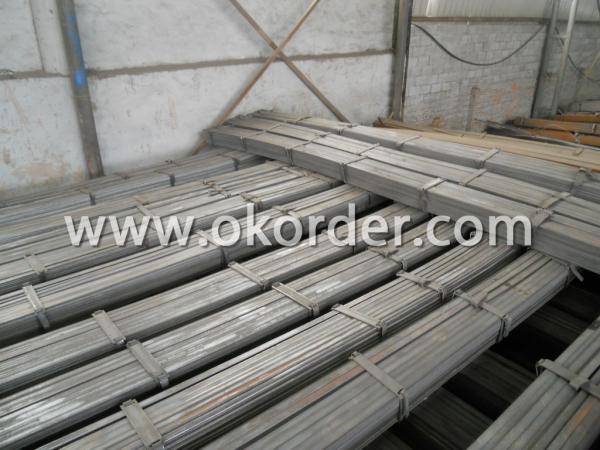
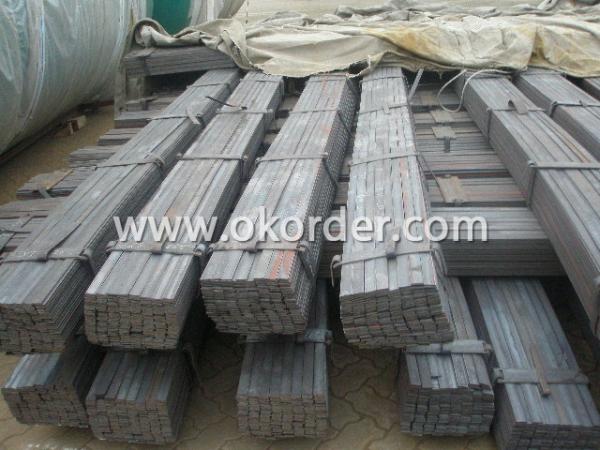
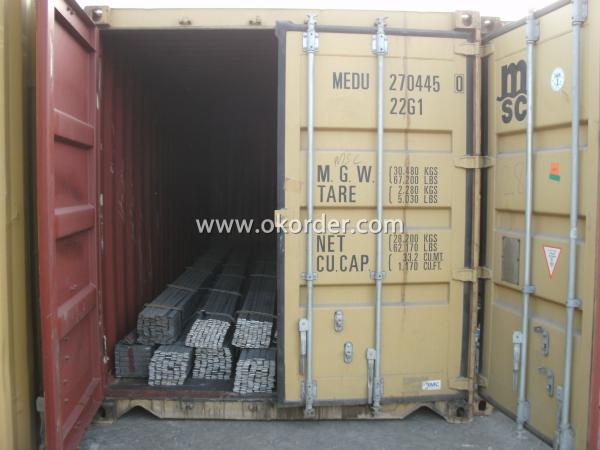
FLATSPACE is specialized in production and sales of slit flat bars. We offered the individuation processing service of slitting and crosscut. Our flat bar the width form 10mm to 1800mm, and thichness from 2.5mm to 25mm.
View Manufacturer's Shop
1. Manufacturer Overview | |
|---|---|
| Location | Hebei, China |
| Year Established | 2009 |
| Annual Output Value | Above US$ 150 Million |
| Main Markets | Southeast Aisa, Middle east, Africa |
| Company Certifications | |
2. Manufacturer Certificates | |
|---|---|
| a) Certification Name | |
| Range | |
| Reference | |
| Validity Period | |
3. Manufacturer Capability | |
|---|---|
| a)Trade Capacity | |
| Nearest Port | Tianjin |
| Export Percentage | 70%-80% |
| No.of Employees in Trade Department | 10-15 people |
| Language Spoken: | English; Chinese |
| b)Factory Information | |
| Factory Size: | Above 20,000 square meters |
| No. of Production Lines | 7 |
| Contract Manufacturing | OEM Service Offered; |
| Product Price Range | Average |
- Q: Are steel flat bars suitable for machining processes?
- Yes, steel flat bars are suitable for machining processes. Steel flat bars are typically made from low-carbon steel, which is known for its excellent machinability. This means that it can be easily cut, drilled, and shaped using various machining techniques, such as milling, turning, or grinding. Additionally, steel is a durable and strong material, making it ideal for machining applications that require high precision and tight tolerances. However, it is important to note that the specific grade and composition of the steel flat bar may affect its machinability. Different grades of steel may have different hardness, toughness, and other properties, which can impact the machining process. Therefore, it is recommended to consult the manufacturer's guidelines or seek professional advice to ensure the suitability of steel flat bars for specific machining processes.
- Q: What are the standard lengths available for steel flat bars?
- The available lengths for steel flat bars differ based on the manufacturer and customer specifications. Typically, these bars come in lengths ranging from 6 to over 20 feet, with variations based on industry standards or customer preferences. Notably, custom lengths can be obtained by cutting or shearing the steel flat bar to the desired size.
- Q: How do steel flat bars perform in extreme weather conditions?
- Steel flat bars are known for their exceptional strength and durability, which makes them highly resistant to extreme weather conditions. They are capable of withstanding high temperatures, heavy rain, snow, and even strong winds. In extreme heat, steel flat bars have a high melting point, which means they can withstand prolonged exposure to intense heat without warping or losing their structural integrity. This makes them ideal for applications in areas with high temperatures, such as deserts or industrial settings. During heavy rain or snowfall, steel flat bars are highly resistant to corrosion and do not rust easily. This makes them suitable for outdoor applications where they may be exposed to moisture for extended periods. Moreover, their smooth surface allows water to run off easily, preventing the accumulation of water and reducing the risk of damage caused by freezing and thawing cycles. In areas prone to strong winds or storms, steel flat bars are known for their exceptional strength and stability. They can withstand high wind pressures and resist bending or breaking, making them a reliable choice for structures such as fences, barriers, and support beams. However, it is important to note that even though steel flat bars are highly resistant to extreme weather conditions, they still require proper maintenance to ensure their longevity. Regular cleaning, inspection, and applying protective coatings can help prevent any potential damage or deterioration caused by weathering. Overall, steel flat bars are a reliable choice for applications in extreme weather conditions due to their strength, durability, and resistance to corrosion.
- Q: How do you remove burrs or sharp edges from steel flat bars?
- One common method to remove burrs or sharp edges from steel flat bars is by using a deburring tool or a file. The deburring tool is specifically designed to remove burrs and can be passed along the edges of the bar to smooth them out. Alternatively, a file can be used to manually file down the burrs and sharp edges until they are smooth.
- Q: Can steel flat bars be used for making support beams or columns?
- Yes, steel flat bars can be used for making support beams or columns. Steel flat bars are versatile construction materials that are commonly used in various structural applications, including support beams and columns. They possess excellent strength and durability properties, making them suitable for bearing heavy loads and providing structural stability. Steel flat bars can be easily fabricated and welded to form the desired shape and dimensions required for support beams and columns. Additionally, their uniformity and consistent dimensions make them ideal for ensuring structural integrity in construction projects. Overall, steel flat bars are a reliable and widely used choice for making support beams and columns due to their strength, durability, and ease of fabrication.
- Q: Can steel flat bars be used in automotive manufacturing?
- Yes, steel flat bars can be used in automotive manufacturing. Steel flat bars are commonly used in various applications within the automotive industry due to their strength, durability, and versatility. They can be used in the fabrication of various automotive components, such as brackets, supports, frames, hinges, and reinforcements. Steel flat bars offer excellent structural integrity and can withstand heavy loads, making them suitable for use in automotive manufacturing. Additionally, steel is a cost-effective material and readily available, making it a popular choice in the automotive industry.
- Q: How do steel flat bars perform in terms of impact resistance?
- The impact resistance properties of steel flat bars are excellent. Their high strength and toughness enable them to endure substantial forces and impacts without experiencing any breakage or deformation. As a result, they are extremely well-suited for industries like construction, manufacturing, and automotive, where impact resistance plays a critical role. Steel flat bars have the capacity to absorb and disperse the energy from an impact, thereby safeguarding the structure or equipment they are employed in. Furthermore, their rigidity and stability contribute to their capability to withstand impact, establishing them as a dependable option for a wide range of structural and load-bearing applications.
- Q: Construction of lightning protection ground galvanized flat steel approach, need to retest test? What's the test?
- Hot rolled flat steel is a general purpose rectangular cross section strip. Its specifications are expressed in millimeters of thickness / width, flat steel can be finished steel, used for components, ladders, bridges and fences, etc.. Flat steel can also be used to weld rigid steel and billets and slabs of laminated sheets. This standard is applicable to hot-rolled flat steel with rectangular cross section. Measurement: flat length and length of flat steel, according to the theoretical weight of delivery.
- Q: Can steel flat bars be used for making bicycle frames?
- Yes, steel flat bars can be used for making bicycle frames. Steel is a commonly used material in bicycle frame construction due to its strength and durability. Flat bars made of steel can provide the necessary rigidity and stability required for a bicycle frame. They can be shaped and welded together to form the various tubes and joints that make up the frame. Additionally, steel is relatively affordable and widely available, making it a popular choice for bicycle manufacturers and hobbyists alike. However, it is important to note that the specific type and quality of steel used can impact the performance and weight of the bicycle frame.
- Q: How do steel flat bars compare to brass flat bars?
- Steel flat bars and brass flat bars have several differences in terms of their properties and applications. Firstly, steel flat bars are known for their high strength and durability. They offer excellent resistance to impact, corrosion, and wear, making them suitable for heavy-duty applications in construction, manufacturing, and automotive industries. On the other hand, brass flat bars are softer and less strong than steel. They are more malleable and ductile, making them easier to shape and form. Brass is commonly used in decorative applications, electrical fittings, musical instruments, and plumbing. Secondly, steel flat bars have a higher tensile strength compared to brass flat bars. This means that steel can withstand higher forces and loads before deforming or breaking. Brass, although weaker, has better electrical conductivity and thermal conductivity compared to steel, making it a better choice for electrical and heat transfer applications. Lastly, steel flat bars are generally more affordable than brass flat bars due to the difference in raw material costs. Steel is widely produced and has a lower price point, while brass is made from a combination of copper and zinc, which can be more expensive. In summary, steel flat bars excel in strength, durability, and affordability, making them suitable for heavy-duty applications. Brass flat bars, on the other hand, offer better electrical and thermal conductivity, along with a malleable nature that makes them suitable for decorative and specialized applications.
Send your message to us
Mild steel flat bars with high quality and good price
- Loading Port:
- Tianjin
- Payment Terms:
- TT OR LC
- Min Order Qty:
- 25 m.t.
- Supply Capability:
- 100000 m.t./month
OKorder Service Pledge
OKorder Financial Service
Similar products
Hot products
Hot Searches
Related keywords
